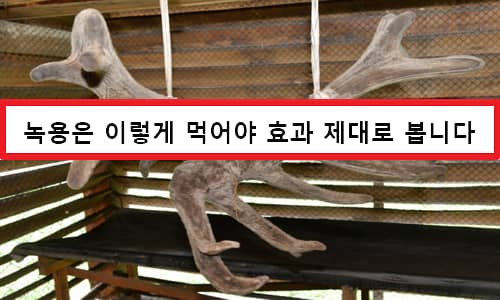Deer velvet benefits, side effects, how to eat - Nutritional tonic for pregnant women and children
Deer velvet Nutrition

| Deer velvet (100g) Nutrition | |||
| Carbohydrate | Protein | Fat | Calories |
| 2g | 1.2g | 0.1g | 14kcal |
| Main Nutrition | Glucosamine, Calcium | ||
| Main Benefits | Nutritional tonic, promotion of health for pregnant women, aid in children's development | ||
| Side Effects | Excessive intake may cause side effects such as indigestion and breathing difficulties. | ||
Deer velvet is the newly sprouted antlers of a deer. It is one of the representative tonics in Oriental medicine and is treated as a precious herb. In Korea, Russian deer velvet is considered the highest quality, and its price is correspondingly higher. After drying, deer velvet is cut into slices and boiled in water. Deer velvet is also available in a stick form, so you can easily squeeze it and eat it. 음식에 넣어 재료로 쓰이는 경우는 드문 편이며, 건강식품이나 약재 형식으로 섭취하는 경우가 일반적입니다. It is rare to use it as an ingredient in food, and it is usually consumed as a health food or medicine.
2. Deer velvet Benefits

1. Nutritional tonic
One of the representative benefits of deer velvet is as a nourishing tonic. Deer velvet contains various nutrients, so when taken by healthy people, it is effective in maintaining health and helps strengthen the body. Because it has the function of treating the weakness of people with weak bodies, it is also very effective as a nourishing tonic for women after and before giving birth to a child. It is also effective in relieving fatigue, making it one of the popular tonics for athletes.
2. Improve joint health
Deer velvet contains an ingredient called glucosamine. This ingredient is involved in joint health, including cartilage, tendons, and bones. This is an amino acid used to create joint structure and maintain and repair joints, thus contributing to joint health. Deer velvet also contains chondroitin, a structural component of joints that helps maintain cartilage elasticity and healthy joint structure. Therefore, taking deer velvet helps improve joint health in people suffering from joint diseases.
3. Brain Health
The phospholipids contained in deer velvet are nutrients that the body uses to build cell walls and human brain tissue. These ingredients help maintain cell membranes and provide nutrients to maintain and support healthy brain function. Deer velvet also has the function of improving blood circulation, which helps improve brain health by facilitating blood supply to the brain.
4. Hematopoiesis
Deer velvet helps increase the number of hematopoietic stem cells by activating them. When hematopoietic stem cells are activated, red blood cells and hemoglobin stimulate them. Therefore, it helps treat postpartum anemia and hemorrhagic diseases caused by excessive blood loss, as well as thrombocytopenia and leukemia. Additionally, it is also rich in iron, which prevents the decrease in hemoglobin concentration and red blood cell count.
5. Child growth and development
Deer velvet helps growing children, children with slow growth, and children suffering from cartilage disease. First, the effect of phospholipids in deer velvet improves brain function and activates the motor area and sensory nerves of the cerebral cortex, helping to enhance concentration and memory, making it effective in the development of intelligence. Additionally, it has the function of promoting differentiation of fracture cells and is effective for growth and development by opening the growth plate.
3. Deer velvet How to eat
4. Deer velvet Side Effect
- Deer velvet has warm properties, so people with high fevers should be careful because excessive consumption may cause side effects such as heart palpitations or indigestion.
- Excessive consumption of deer velvet may cause side effects such as itching of the skin and difficulty breathing, so it must be taken after consulting a specialist.
- People suffering from cardiovascular diseases such as high blood pressure or angina pectoris are advised not to consume Deer velvet as side effects may occur.